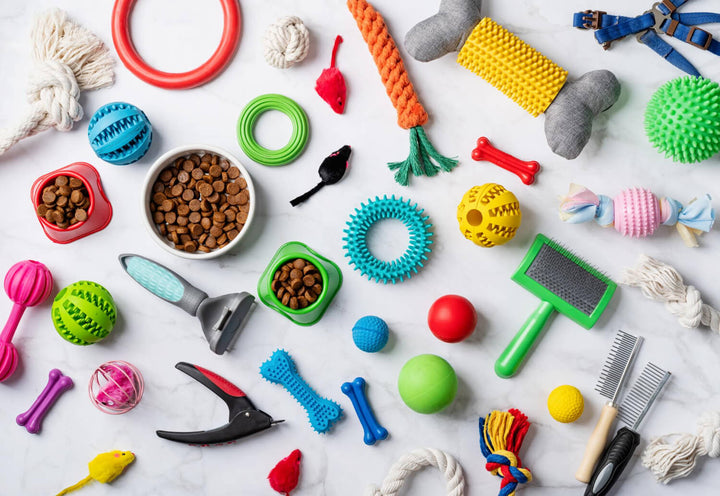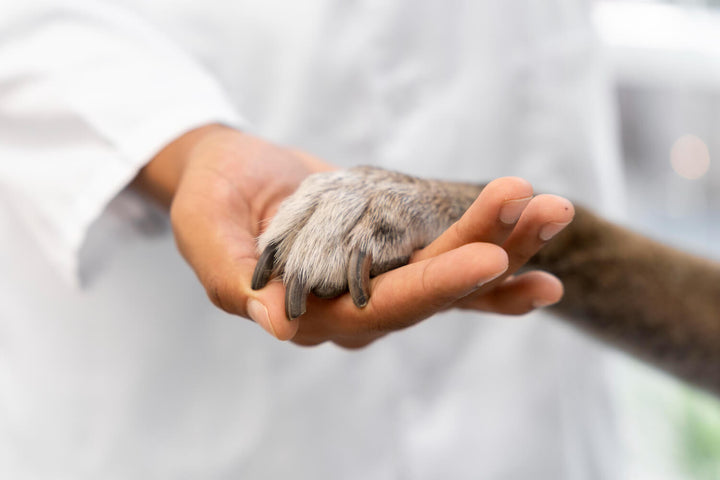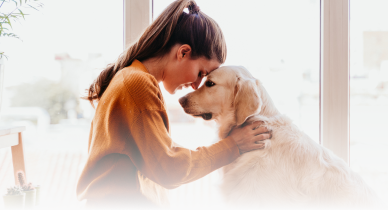The Labrador Retriever, with its boundless enthusiasm, unwavering loyalty, and infectious zest for life, stands as a true embodiment of the ultimate canine companion. Renowned for its friendly nature and versatile skills, this breed has won the hearts of families, athletes, and service professionals alike. From its origins as a skilled retriever to its present-day status as a beloved household member, the Labrador Retriever is a breed that captures the essence of joy, devotion, and endless tail-wagging charm.
Did You Know these Facts about the Labrador Retriever?
-
Labradors are natural-born swimmers, thanks to their water-resistant coats, webbed toes, and strong swimming skills. Their love for water can be traced back to their ancestral roots as fishermen's assistants in Newfoundland.
-
Labradors are renowned for their exceptional sense of smell, which has led them to excel as search and rescue dogs, guide dogs for the visually impaired, and even skilled detection dogs for various agencies.
-
Their dense, double-layered coat comes in three primary colors: black, yellow, and chocolate. The coat not only provides protection from the elements but also makes them well-suited to various climates and terrains.
-
A Labrador's affectionate nature is often displayed through a charming behavior known as the "Lab Lean." They have a tendency to lean their body weight against their human's legs, seeking attention and closeness.
- Accolades in the Spotlight: Labradors have made their mark in pop culture, starring in movies, TV shows, and commercials. Their gentle demeanor and expressive eyes make them natural actors, further solidifying their place in the hearts of dog lovers worldwide.
The Labrador Retriever holds an unshakable #2 position as one of the most popular dog breeds globally, according to the American Kennel Club. Its enduring popularity can be attributed to its versatile talents, amiable personality, and adaptability to various lifestyles. Renowned for their loyalty, intelligence, and boundless energy, they capture the affections of ev eryone seeking a lifelong canine companion.

Traits of the Labrador Retriever Breed
Personality. Labradors are known for their friendly, outgoing, and eager-to-please personalities. Their gentle demeanor, combined with their love for play, makes them wonderful companions for people of all ages.
Family Life. Labradors thrive in family settings, forming strong bonds with adults and children alike. They relish in participating in family activities, from outdoor adventures to quiet cuddle sessions on the couch.
Physical Traits, Colors, and Markings. Labradors possess a sturdy, medium-to-large build. Their double coat provides insulation against cold weather and water, and their coat colors range from classic black and vibrant yellow to rich chocolate. They may have solid coats or subtle markings.
Social Nature. Labradors are incredibly social dogs that enjoy interactions with both humans and other pets. Their friendly disposition and adaptability make them excellent candidates for multi-pet households and dog-friendly communities.
Average Sizes & Life Expectancy
- Height: 21 to 24.5 inches tall (53 to 62 cm)
- Weight: 55 to 80 pounds (25 to 36 kg)
- Life Expectancy: Around 10 to 12 years
Detailed Description of the Labrador Retriever Breed
The Labrador Retriever, often referred to simply as the "Lab," stands as a beacon of unwavering devotion, boundless energy, and uncontrollable affection. From its distinctive physical features to its versatile talents and heartwarming personality, this breed has earned its esteemed position as one of the most cherished and beloved canine companions worldwide. Do let's delve deeper into the world of Labradors, exploring their captivating traits, exceptional adaptability, and enduring contributions to history and popular culture.
Physical Appearance. Labradors boast a balanced and athletic physique that exudes strength and grace. With a medium-to-large build, their bodies are well-muscled and powerful, setting the stage for their dynamic abilities. The hallmark of a Labrador's appearance is their expressive face, adorned with a pair of soulful eyes that radiate intelligence and warmth. Labradors come in three primary coat colors: black, yellow, and chocolate. Each hue is a testament to their versatile genetics, adding to their individuality and charm. The coat is dense, water-resistant, and equipped with a soft undercoat that provides insulation and protection from the elements.
Playful and energetic. Labradors possess a zest for life that is infectious. Their playful nature and boundless energy ensure that there is never a dull moment when a Labrador is around. From a game of fetch to a frolic in the park, Labradors revel in engaging activities that allow them to showcase their athleticism and enthusiasm.
Great with children. Labradors' gentle and patient disposition makes them exceptional playmates for children. Their innate protectiveness and inherent kindness create an environment of trust and affection that nurtures lifelong friendships between Labradors and the young members of their families.
Social Butterflies. Labradors thrive on human interaction and thrive in social environments. Their inherent friendliness extends to interactions with other dogs and even different species, making them valuable additions to multi-pet households.
Adaptability. One of the Labrador's standout attributes is its remarkable adaptability. This breed seamlessly transitions from dynamic outdoor activities to cozy indoor relaxation, making them well-suited for various living situations. Labradors are equally content in spacious suburban homes, urban apartments, or rural settings. Their flexible nature ensures they thrive in environments that prioritize companionship, interaction, and physical activity.
Care Guidelines. Labradors have a robust need for regular exercise to channel their energy and maintain their overall well-being. Engaging in daily walks, play sessions, and mentally stimulating activities keeps their minds sharp and their bodies healthy. While Labradors have a relatively low-maintenance coat, regular brushing helps manage shedding and promotes healthy skin and fur. Routine nail trims, dental care, and ear cleaning are essential aspects of their grooming routine.
Training Strategies. Labradors are intelligent and eager learners, making training sessions enjoyable and rewarding. Positive reinforcement methods that involve treats, praise, and play are particularly effective in shaping their behaviors and teaching commands.
Notable in History and Pop Culture. Labradors' legacy extends beyond their role as cherished companions, reaching into areas of service, sports, and even the realm of pop culture.
Labradors excel as service dogs for people with disabilities, therapy dogs providing comfort, and guide dogs aiding the visually impaired.
Their intelligence, empathy, and gentle disposition make them exceptional partners in various service roles. Labradors shine in the sports world, participating in activities such as agility, obedience, and retrieving competitions. Their enthusiasm for play and their aptitude for learning enable them to excel in a wide range of canine sports.
Labradors have graced the big screen and small screen alike, captivating audiences with their relatable and heartwarming portrayals. Their endearing appearances in movies, TV shows, and commercials showcase their universal appeal and enduring popularity.
In conclusion. In the presence of a Labrador Retriever, one discovers a boundless source of affection, joy, and companionship. Their charming blend of playfulness, intelligence, and loyalty creates an unbreakable bond that transcends time and captures the essence of what it truly means to be a beloved canine companion. From their historical contributions to their modern-day roles, Labradors stand as a testament to the enduring partnership between humans and dogs, enriching lives and hearts with their unwavering devotion and boundless spirit.
What to expect when living with the Labrador Retriever Breed
Owning a Labrador Retriever is an invitation to a world filled with boundless affection, endless play, and unwavering companionship. Their personality is a tapestry woven with kindness, exuberance, and an insatiable appetite for adventure. As you embark on this wonderful journey, here's what you can expect when living with this remarkable breed.
Personality. Labradors are renowned for their friendly and amiable nature. They possess an innate charm that instantly endears them to everyone they meet. Their affection knows no bounds, and they are quick to form deep bonds with their human family members. Labrador Retrievers thrive on interaction and display an unwavering loyalty that cements them as cherished members of the household. They have an inherent gentleness that makes them exceptional companions for families, children, and seniors alike.
Their patient and tolerant nature ensures that they seamlessly integrate into various family dynamics, spreading joy wherever they go. Labradors have an infectious zest for life that radiates through their every action. Whether engaging in a spirited game of fetch, joining you for a jog, or simply enjoying quality time in the backyard, their playful energy injects a dose of vitality into daily routines.
Ideal Environment. Labrador Retrievers are versatile and adaptable, flourishing in a wide range of living environments. They are equally content in city apartments, suburban homes with yards, or rural settings with open spaces. Labradors are happiest when they are an integral part of the family's daily activities, whether that involves indoor play, outdoor adventures, or simply lounging together. Labrador Retrievers are well-suited for families that prioritize companionship, interaction, and shared experiences. They thrive in households with children, forming close bonds and serving as patient playmates who contribute to the joyful memories of growing up.
Maintenance Level. Labradors have relatively low grooming requirements, but regular care is essential to keep them healthy and happy. While their short coat minimizes shedding, regular brushing helps maintain healthy skin and coat. They may shed more during shedding seasons, and routine grooming can manage this effectively.
Labrador Retrievers have high energy levels and require daily exercise and mental stimulation. Regular walks, play sessions, and activities that engage their minds are crucial to prevent boredom and ensure their well-being.
Overall Health Expectations and best Health Tests for the Labrador Retriever Breed
Health Considerations. Labrador Retrievers are generally robust and healthy dogs, but like all breeds, they may be prone to certain health conditions. Being proactive about their health is essential to ensure a long and vibrant life for your furry companion. Here's what you should know about their health expectations and the recommended health tests for the breed.
While Labradors are known for their vitality, they can be susceptible to a few health issues that are worth monitoring. These include:
-
Hip and Elbow Dysplasia. Labradors may be prone to hip and elbow dysplasia, which are developmental conditions affecting the joints. Regular check-ups and monitoring are crucial to catch any signs early.
-
Obesity. Due to their hearty appetite and love for food, Labradors are at risk of obesity. Maintaining a healthy weight through proper diet and exercise can prevent related health problems.
-
Eye Conditions. Labradors can be predisposed to eye conditions such as cataracts and progressive retinal atrophy (PRA). Regular eye examinations are important to detect and manage these issues.
-
Ear Infections. Their floppy ears can trap moisture and debris, making Labradors more prone to ear infections. Regular cleaning and proper care can help prevent infections.
Recommended Health Tests. To ensure the well-being of your Labrador, consider the following health tests:
-
Regular hip and elbow evaluations, such as radiographs, help detect joint issues early and guide preventive measures.
-
Regular eye examinations by a veterinary ophthalmologist can catch eye conditions in their early stages.
-
Regular weight monitoring and guidance from your veterinarian can help prevent obesity-related health issues.
-
Periodic cardiac evaluations, including echocardiograms, can help identify any heart conditions.
- Routine blood tests can assess organ function and overall health, guiding early intervention if any issues arise.
Best Nutrition, Diet & Supplements for the Labrador Retriever
Nutrition and Diet. Opt for high-quality commercial dog food that is specifically formulated for Labrador Retrievers. Look for options that provide a balanced mix of protein, carbohydrates, healthy fats, and essential nutrients.
Labradors' love for food can lead to overeating and potential obesity. Follow your veterinarian's guidance on portion control to maintain a healthy weight.
A diet rich in lean protein supports muscle maintenance and overall well-being. Chicken, turkey, fish, and lean meats are excellent protein sources. Include sources of healthy fats, such as fish oil or flaxseed oil, to promote a glossy coat and support joint health.
Incorporate whole grains like brown rice and oats for sustained energy and dietary fiber to support digestive health.
Supplements. While Labradors typically receive essential nutrients from a balanced diet, some supplements can further support their health. Omega-3 Fatty Acids promote a healthy coat, skin, and joint function. Glucosamine and Chondroitin support joint health and mobility, especially important for Labradors prone to joint issues. Probiotics maintain and support digestion.
Foods to Avoid. While Labrador Retriever have hearty appetites, it's important to avoid certain foods that can be harmful to their health. These include chocolate, grapes, raisins, onions, garlic, and foods high in salt or fat.
Grooming Requirements for the Labrador Retriever Breed
Grooming a Labrador Retriever is an art that not only enhances their appearance but also contributes to their overall health and well-being. While Labradors have relatively low-maintenance coats, regular grooming is essential to keep them looking their best and feeling comfortable. Here's what you need to know about their grooming requirements, shedding tendencies, and paw care.
Coat Maintenance and Shedding. Labradors have a short, double coat that is relatively easy to care for. Regular brushing, at least a few times a week, helps to remove loose hair, distribute natural oils, and prevent matting. During shedding seasons, which typically occur twice a year, more frequent brushing can help manage shedding. While their short hair may not be as noticeable as longer haired breeds, regular brushing and occasional baths can help minimize shedding around the house. Using a shedding tool or de-shedding mitt can be particularly effective in removing loose hair.
Paw Care and Hygiene. Labradors are active and may encounter various surfaces, so proper paw care is important. Regularly check their paws for any signs of injury, debris, or irritation. Keep nails trimmed to a safe length to prevent discomfort or issues with mobility. Paw balm can be applied to keep paw pads moisturized and protected.
Ears and Dental Care. Regularly inspect and clean their ears to prevent infections. Brushing their teeth regularly and providing dental chews or toys helps maintain their oral health.
Bathing Frequency. Labradors typically do not require frequent baths unless they get particularly dirty or smelly. Over-bathing can strip their coat of natural oils, so aim for bathing every 2-3 months or as needed.
Exercise Required for the Labrador Retriever Breed
Labrador Retrievers are a breed that thrives on physical activity and mental stimulation. Their high energy levels and athletic nature make exercise a crucial component of their well-being. Engaging in the right types and amounts of exercise ensures a happy and healthy Labrador.
They are versatile and enjoy various forms of exercise, from brisk walks and jogging to swimming and playing fetch. Engaging in activities that challenge their mind and body, such as agility training or interactive toys, keeps them content and fulfilled.
Aim for at least 60 to 90 minutes of exercise each day. Split this time into multiple sessions to prevent overexertion, especially during hot weather. Engaging in activities that match their energy levels, like running or playing fetch, is particularly satisfying for Labradors Retrievers.
Labradors are intelligent and curious, so mental exercises are equally important. Puzzle toys, obedience training, and scent games tap into their cognitive abilities and keep them engaged.
Training Tips for the Labrador Retriever Breed
Training a Labrador Retriever is a rewarding journey that cultivates a strong bond and ensures their proper behavior in various situations. Their eager-to-please nature and intelligence make them excellent learners, but effective training requires consistency, patience, and positive reinforcement.
-
Positive Reinforcement. Labradors respond well to positive reinforcement techniques, which involve rewarding desired behaviors with treats, praise, or toys. This approach fosters a trusting and cooperative relationship.
-
Early Socialization. Expose your Labrador to various people, animals, environments, and situations from a young age. Socialization helps them develop confidence, adaptability, and appropriate behavior.
-
Basic Commands. Teach essential commands such as sit, stay, come, and heel. These commands ensure safety, control, and effective communication between you and your Labrador.
-
Crate Training. Introduce crate training as a safe and comfortable space for your Labrador. This not only aids in-house training but also provides them with a secure retreat.
-
Consistency. Consistency is key to successful training. Use the same cues, rewards, and commands to avoid confusion and promote quick learning.
-
Avoid Punishment. Avoid harsh training methods or punishment, as they can damage the trust between you and your Labrador and hinder their progress.
- Patience and Fun. Training should be enjoyable for both you and your Labrador. Keep sessions short, engaging, and positive to maintain their enthusiasm and eagerness to learn.
Training your Labrador Retriever is an investment that yields a lifetime of well-behaved companionship. By focusing on positive reinforcement, early socialization, and consistency, you'll help your Labrador become a well-mannered and joyful member of your family, ready to share in a wealth of experiences and adventures.
The Labrador Retriever Breed is Suitable For
The Labrador Retriever's adaptable nature and gentle temperament make it an ideal choice for a wide range of homes and lifestyles. Whether you reside in a bustling city apartment, a suburban house with a yard, or even a rural farmhouse, a Labrador can seamlessly integrate into your family and become a cherished companion.
-
Labradors are renowned for their patient and gentle demeanor, making them excellent companions for families with children of all ages. Their tolerance and affectionate nature create a harmonious environment where children can interact, play, and form lasting bonds with their furry friend. Moreover, Labradors often get along well with other pets, including cats and other dogs, when introduced and socialized properly.
- While Labrador Retrievers appreciate a yard to romp and play in, they can adapt well to various living spaces. Apartment living is feasible as long as they receive ample exercise and mental stimulation. Labradors are happiest when they are an integral part of family activities, regardless of the size of the home.
The Labrador Retriever Breed is Not Suitable For
While Labrador Retrievers are adaptable, there are certain environments and situations that may not be suitable for their well-being.
-
Labradors thrive on human interaction and companionship. Environments where they are left alone for extended periods can lead to boredom, anxiety, and destructive behaviors. They require regular interaction, mental stimulation, and physical activity to maintain their well-being.
- Labradors are an active breed that thrives on exercise and engagement. Homes with minimal physical activity and limited outdoor space may not provide the ideal environment for their energetic needs.
Famous Labrador Retriever Owners
-
Prince William and Duchess Kate Middleton -The royal couple welcomed a black Labrador named Lupo into their family. Lupo was known for his charming presence and was often seen in family photos.
-
Drew Barrymore - The Hollywood actress and producer is a devoted Labrador lover. She has shared her life with multiple Labradors, showcasing their role as loyal and loving companions.
- Adam Sandler - The beloved actor and comedian is a proud owner of a Labrador named Matzoball. Sandler and Matzoball's companionship has even been the subject of heartwarming stories.
Accomplishments of the Labrador Retriever Breed
Labradors excel in various service roles, including guide dogs for the visually impaired, therapy dogs, and search and rescue dogs. Their intelligence, loyalty, and willingness to work make them invaluable partners in these vital roles.
Labradors have made their mark in movies, TV shows, and literature. They are often depicted as loyal and relatable characters, capturing hearts in stories that celebrate their genuine nature and steadfast devotion. Their endearing portrayals have contributed to their enduring popularity and recognition.
Labradors shine in various canine sports, including agility, obedience, and retrieving competitions. Their athleticism, intelligence, and enthusiasm make them formidable competitors and ambassadors for the breed's capabilities.
The Labrador Retriever's enduring appeal can be attributed to its versatile nature, family-friendly disposition, and remarkable contributions to service, sports, and popular culture. Whether depicted in heartwarming stories or making a tangible difference as service companions, Labradors continue to leave an indelible mark on the hearts of dog lovers and enthusiasts around the world.
The History of the Labrador Retriever Breed
The Labrador Retriever's history is a tale of purposeful breeding, versatile skills, and enduring popularity. Originating from the Canadian island of Newfoundland, Labradors were refined through careful breeding and selection to become one of the most beloved and versatile dog breeds in the world.
Origins and Purpose. In the early 19th century, the Labrador Retriever emerged as a distinct breed from a lineage of working dogs in Newfoundland, Canada. Initially referred to as the "St. John's dog" or "Lesser Newfoundland," these dogs were prized for their exceptional swimming and retrieving abilities. They were invaluable companions to fishermen, assisting in retrieving fishing nets, lines, and caught fish from the frigid waters of the North Atlantic.
Arrival in England. During the early 19th century, the breed's potential as a skilled retriever caught the attention of British sportsmen. They were imported to England, where their innate abilities were further developed through selective breeding. The dogs' exceptional aptitude for retrieving game from both water and land made them indispensable for hunting waterfowl and upland game birds.
Refinement of Traits. By the mid-19th century, the breed began to take on the characteristics that define the modern Labrador Retriever. Breeders carefully selected individuals with desirable traits such as a strong work ethic, gentle temperament, and versatile skills. The infusion of bloodlines from other breeds such as the Flat-Coated Retriever, Greyhound, and even the Newfoundland dog contributed to the Labrador's distinctive appearance and abilities.
Rise in Popularity. Labradors' reputation as dependable and affectionate companions quickly spread, leading to their widespread popularity. The breed's rise in prominence was marked by their recognition by kennel clubs and breed standards, including the official recognition by The Kennel Club (UK) in 1903 and the American Kennel Club (AKC) in 1917.
Evolution in Modern Times. Over the years, Labradors have continued to evolve and excel in various roles. Their exceptional intelligence and trainability led to their inclusion as service dogs, therapy dogs, and search and rescue dogs. Their innate desire to please and aptitude for learning also made them a favorite in various canine sports and competitions.
Today, the Labrador Retriever is celebrated not only for its working prowess but also for its unwavering loyalty, gentle nature, and adaptability as a cherished family companion. They have earned a special place in households worldwide, enriching lives with their boundless affection and genuine companionship.
From their humble beginnings as indispensable fishing aids to their current status as beloved household members and versatile working dogs, the Labrador Retriever's history is a testament to the breed's resilience, versatility, and enduring legacy. Their remarkable journey from the shores of Newfoundland to the hearts of dog lovers across the globe showcases their exceptional contribution to both human companionship and various essential roles in society.
The Labrador Retriever Breed Standard
The Labrador Retriever falls under the Sporting Group according to the American Kennel Club (AKC). This group encompasses breeds developed to assist hunters in various capacities, including retrieving game from water and land.
The AKC's Breed Standard for the Labrador Retriever serves as a beacon for breeders, judges, and enthusiasts alike. It outlines the quintessential characteristics that define the breed, encompassing elements such as size, coat, color, head, tail, and gait. This standard not only preserves the breed's integrity but also guides the evaluation of dogs in conformation shows.
The Labrador Retriever Club, Inc. (LRC), stands as the premier resource for Labrador enthusiasts and owners. To explore a wealth of information about the breed, health initiatives, events, and responsible breeding practices, visit their official website: Labrador Retriever Club, Inc..
General Appearance
The Labrador Retriever's distinct and captivating appearance is a harmonious blend of form and function, exuding athleticism and charm. From its well-proportioned head to its wagging tail, every aspect of this breed's physique reflects its versatile nature and inherent beauty.
Head. The Labrador Retriever's head is broad, clean-cut, and showcases a strong and intelligent expression. Their eyes, set wide apart, exude warmth and a kind, gentle demeanor. Dark, expressive eyes convey intelligence and an engaging personality that readily captures the hearts of all who encounter them.
Muzzle and Nose. The breed's muzzle is of medium length and straight, serving both practical and aesthetic purposes. The nose, typically black or brown, possesses an acute sense of smell that complements their retrieving prowess, while the sturdy muzzle structure aids in carrying objects with a gentle mouth.
Ears. Labradors sport drop ears that lie close to the head, framing their expressive features. These ears enhance their attentive and responsive nature, allowing them to be attuned to their surroundings and humans.
Teeth. A strong scissor bite and healthy teeth support their purpose as retrieving dogs. Their teeth align cleanly, allowing them to carry game without causing harm, exemplifying their gentle touch even when engaging in challenging tasks.
Neck. A powerful neck melds seamlessly with the body, highlighting the breed's muscular build. The neck is of sufficient length to convey a balanced and dignified stance, adding to their commanding presence.
Body. Labradors possess a compact yet athletic body, projecting strength and agility. A deep chest and well-sprung ribs provide ample lung capacity for endurance, while a level topline and strong back underline their robust physique.
Tail. The breed's otter-like tail, set fairly high and thick at the base, extends with a confident wag that reflects their exuberant spirit. The tail's purpose is multi-faceted: it acts as a rudder when swimming, an expressive barometer of emotions, and a beacon of their boundless enthusiasm.
Coat. Labradors showcase a short, dense double coat that serves as an armor against various weather conditions. Water-resistant and insulating, this coat supports their aptitude as water retrievers. Coat colors encompass chocolate, black, and yellow, each shade enhancing their individual charm.
Size. Labradors stand at a medium to large size, embodying an ideal balance of strength and agility. Males typically measure between 22.5 to 24.5 inches at the shoulder, while females range from 21.5 to 23.5 inches.
Gait. A Labrador's gait is a reflection of their well-coordinated movement and stamina. As they walk or trot, their effortless stride radiates energy and purpose, exhibiting an impressive reach and drive that showcases their innate athleticism.
From head to tail, the Labrador Retriever's general appearance speaks volumes about their exceptional qualities and versatile capabilities.
Reputable Breeders
For those seeking to embark on a lifelong journey with a Labrador Retriever, here are prominent breeders known for their dedication to the breed's health and temperament:
Top Shelters for Adoption
For those considering adoption and wishing to give a Labrador Retriever a loving forever home, these shelters are valuable allies:
Top 5 Frequently Asked Questions & Answers about the Labrador Retriever Breed
Are Labradors good with children?
Yes, Labradors are renowned for their gentle and patient nature, making them excellent companions for families.
Do they shed a lot?
Labradors have a double coat that sheds moderately year-round, with increased shedding during seasonal changes.
How much exercise do Labradors need?
Labradors require regular exercise, including daily walks and playtime, to keep them mentally and physically stimulated.
Are they easy to train?
Labradors are highly trainable due to their intelligence and eagerness to please. Positive reinforcement methods work best.
Do Labradors have any common health issues?
Labradors can be prone to hip and elbow dysplasia, obesity, and certain genetic conditions. Regular veterinary check-ups are essential.
A Final Tip for Bringing a Labrador Retriever into Your Life
Embracing a Labrador Retriever into your life is an invitation to experience joy, loyalty, and a lifelong bond like no other. Their exuberance for life, gentle disposition, and unwavering devotion make them exceptional companions for families, singles, and seniors alike.
As you welcome a Labrador Retriever into your heart and home, be prepared for endless tail wags, playful antics, and a love that knows no bounds. The Labrador Retriever's unique ability to bring happiness and warmth to every corner of your life is a gift that keeps on giving, ensuring a journey filled with cherished memories and enduring companionship.
Valuable Resources for Your Journey to Parenting a Labrador Retriever
At Felicitails you will find many wonderful services, supplies and guides for your life ahead with a loving pup at your side.

Hope You Enjoyed The Read!

Tag Cloud

A warm welcome from Lindsay & Huck (my English Pointer). Hope you enjoy the read and find just what you are looking for when it comes to living your best life with your loved pets.

-
Dog Breeds
(42)
-
Emotional Support Animals
(10)
-
Dog Grooming
(6)
-
Dog Health
(18)
-
Life with a Dog
(18)
-
Dog Nutrition
(11)
-
Service Animals
(11)
-
Dog Training
(5)







